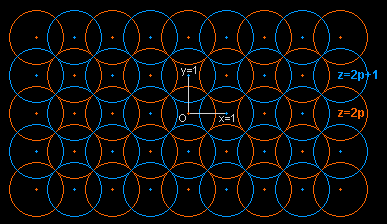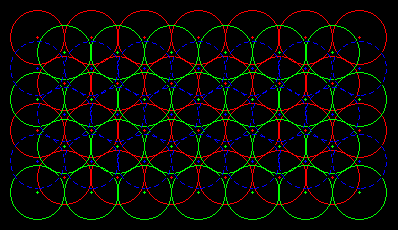

 |
 |
A close packing of identical spheres is an arrangement with a maximal density (fraction of volume filled by the spheres). The periodic close packing shown above left (the orange layers have even altitude 2p, and the blue ones odd altitude 2p+1) is the cubic close packing; its density is about 0.74.
The radius of the spheres is r=sqrt(2)/2 ("sqrt" means "square root"); the centers lay on a diagonal square grids and the sums of their coordinates are all even (they are odd for centers of the holes). Let's notice that each sphere is surrounded by twelve spheres (4 of the same color, and 2x4=8 of the other color) whose centers are the vertices of a cuboctahedron, and that if we symmetrically squeeze this packing each sphere is deformed into a rhombic dodecahedron (dual of the cuboctahedron).
The CCP can also be build up with layers where each sphere is surrounded by six spheres (above right and below middle) and touches three spheres from the layer below (blue) and three more from the layer above (green).
Finally there is a third way to look at the CCP, again with two layers (below right); but this time the centers of the spheres lay on rectangular grids. Nine spheres build a square prism (eight at the vertices and one at the center) with the rectangles as lateral faces.
This third stacking feature has first be highlighted by Steve Waterman.
|
|
|
|
Be patient during the initialization!
Different views allow to see the polyhedral blocks and the different corresponding polyhedra.
Please wait until all the applets are visible before using these links which open new windows.
|
|
The CCP can be viewed with three layers (on the left); there is also a different arrangement with only two layers which builds an other packing: the hexagonal close packing or HCP (on the right).
In an HCP the centers of the twelve spheres are the vertices of a polyhedron sometimes called "anti cuboctahedron", and if this packing is squeezed each sphere is deformed into an "anti rhombic dodecahedron". |
|
| Why are these packings called "cubic" and "hexagonal"?
In the CCP or FCC ("face centered cubic") two tetrahedra, each with six spheres as base and one as apex, build a cube (14 spheres in all: 8 at the vertices and 6 at the faces' centers). In the HCP an hexagonal prism can be highlighted. |
| Remark:he layout of the spheres in a CCP reveals a funny property : the midpoints of the base's sides of a regular tri-right-angled tetrahedron define a regular tetrahedron with same height.
In a unit cube the computation of the pyramids' volumes (respectively 1/6 and 1/3) proves the same result and moreover shows that the heights are one third and two thirds of the cube's diagonal. |
|
|
| On the grid build by the centers of close packed spheres with diameter sqrt(2) there are three simple space filling polyhedra:
• a cube centered at a void, with edge 2, • an hexagonal prism centered at a void, with base's side sqrt(2) and height 2sqrt(3)=h, • a square prism centered at a point, with base's side sqrt(2) and height 2. remarks:
The centers of the three types of polyhedra define three new grids (below).
|
| |
|
|
|
|
And for those who are interested, other pop-up windows: three assortments of polyhedra, three blocks of polyhedra, a block of cubes, a block of hexagonal prisms, a block of square prisms, the three grids and the prisms related to a cube (12 square prisms associated by pairs to the cube's faces and 4 hexagonal prisms with axes the cube's diagonals).
You may arrange the pop-up windows in cascade as you open them and to see them all minimize the main window.
The two other classical space filling polyhedra, the rhombic dodecahedron and the truncated octahedron, also appear in the CCP.
A last pop-up window with a brilliant display of all these polyhedra: a pair of cubes, a "trio" of hexagonal prisms, a pair of square prisms, a rhombic dodecahedron and a truncated octahedron.
Don't miss Waterman's polyhedra: an other way to define polyhedra with the CCP.
Thanks to Steve for his kind help and pertinent suggestions during the draw up of this page.
| references: |
• les polyèdres de coordination en cristallographie (Bulletin de l'Union des Physiciens) in French
• cristallographie: introduction - cristallochimie - les systèmes cristallins - l'organisation des atomes - propriétés des minéraux (in French) |
home page
 |
convex polyhedra - non convex polyhedra - interesting polyhedra - related subjects | January 2004 updated 03-02-2004 |